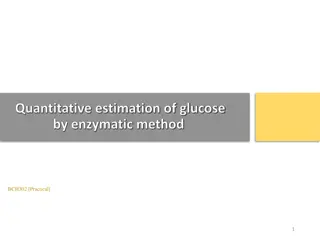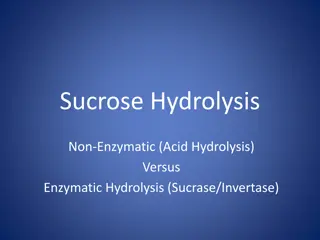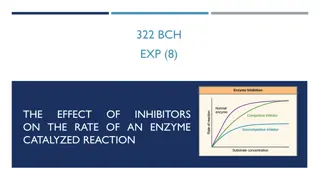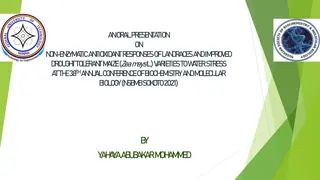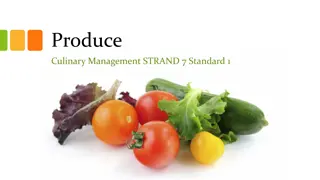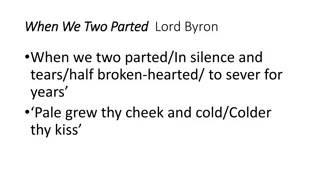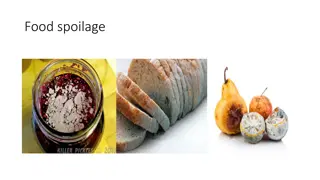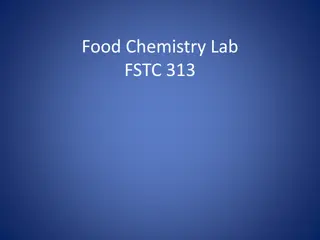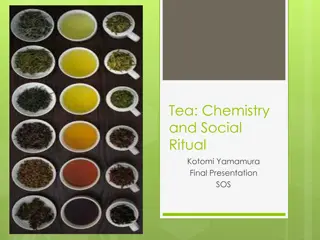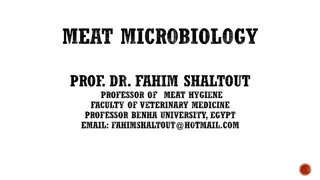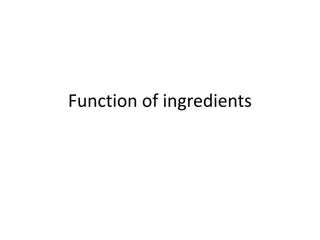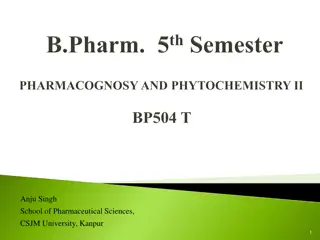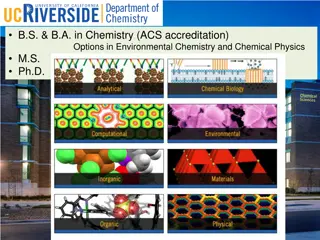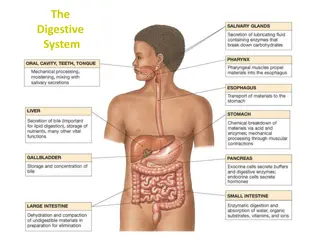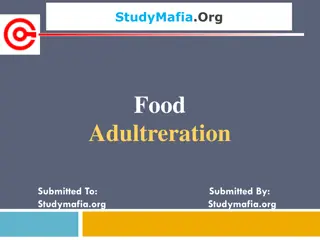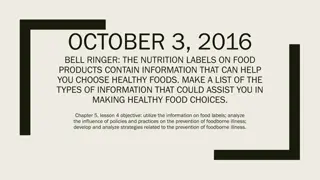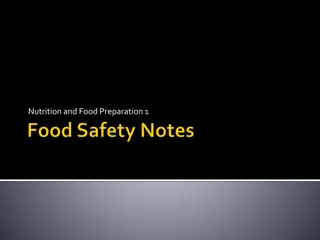Understanding Enzymatic Browning in Food Chemistry
Enzymatic browning is a chemical reaction that causes fruits and vegetables to turn brown when exposed to oxygen. This process, driven by enzymes like polyphenol oxidase (PPO), leads to the formation of brown pigments called melanins. Discover how enzymatic browning happens, its impact on various foods, and methods to control it, from blanching to using antioxidants and genetic engineering.
Download Presentation

Please find below an Image/Link to download the presentation.
The content on the website is provided AS IS for your information and personal use only. It may not be sold, licensed, or shared on other websites without obtaining consent from the author. Download presentation by click this link. If you encounter any issues during the download, it is possible that the publisher has removed the file from their server.
E N D
Presentation Transcript
Browning Dr.Anamika Dixit
Browning is the process of food turning brown due to the chemical reactions that take place within. The process of browning is one of the chemical reactions that take place in food chemistry and represents an interesting research topic regarding health, nutrition, and food technology. Browning is the process of food turning brown due to the chemical reactions that take place within. The process of browning is one of the chemical reactions that take place in food chemistry and represents an interesting research topic regarding health, nutrition, and food technology.
Type of browning Enzymatic BrowningLight colour Fruits and vegetables darken when exposed to air as a result of the presence of oxidative enzymes. Enzymatic browning occurs in those fruits and vegetables when the cellular organization is disrupted by cutting,...
How does enzymatic browning happen? Enzymatic browning affects mostly fruits and vegetables. When you peel or cut open a fruit with a knife, oxygen is introduced to the damaged part. The presence of oxygen triggers the enzymes, polyphenol oxidase (PPO) in apples for example, to oxidize phenolic compounds in the tissues. This results in formation of quinones, which polymerize to form brown pigments called melanins.
Not only PPO in present in fruits and vegetables. PPO is also responsible for the black spots in crustaceans like shrimps and prawns. The black spots begin to manifest hours or days after harvest.
The ways to control browning To increase the yield and inhibit PPO in foods, many methods are used. These methods are classified into two groups: chemical methods and physical methods. These physical methods work by the use of high or low temperature, by removing oxygen, and irradiation. They work by destroying the enzymes, slowing down the enzyme activity or by oxygen removal. While chemical methods include the use of antioxidants, acidifying agents and/or chelating agents. Also, a new way to fight browning is also starting to gain a following genetic engineering.
Blanching One common way of using high temperature to stop enzymatic browning is blanching. Through this method, the fruit or vegetable is heated in a short time (a few minutes). And then treated with cold air or iced water to immediately bring the temperature down. Not only it slows enzyme activity down. It also helps clean fruits and vegetables of dirt and microorganisms, and retain nutrients. As a part of the pre-treatment process, blanching is widely used in many parts of the food manufacturing industry. For example, when preparing vegetables for freezing, blanching is necessary to stop the enzyme activity that may affect the color, texture, and flavor during storage. One common way of using high temperature to stop enzymatic browning is blanching. Through this method, the fruit or vegetable is heated in a short time (a few minutes). And then treated with cold air or iced water to immediately bring the temperature down. Not only it slows enzyme activity down. It also helps clean fruits and vegetables of dirt and microorganisms, and retain nutrients. As a part of the pre-treatment process, blanching is widely used in many parts of the food manufacturing industry. For example, when preparing vegetables for freezing, blanching is necessary to stop the enzyme activity that may affect the color, texture, and flavor during storage.
REFRIGERATOR One common way of using high temperature to stop enzymatic browning is blanching. Through this method, the fruit or vegetable is heated in a short time (a few minutes). And then treated with cold air or iced water to immediately bring the temperature down. Not only it slows enzyme activity down. It also helps clean fruits and vegetables of dirt and microorganisms, and retain nutrients. As a part of the pre-treatment process, blanching is widely used in many parts of the food manufacturing industry. For example, when preparing vegetables for freezing, blanching is necessary to stop the enzyme activity that may affect the color, texture, and flavor during storage.
Oxygen removal Enzymatic browning can only take place in the presence of oxygen. When the oxygen removed, the browning process slows down. There are a few ways to achieve this. Today, Vacuum packaging and modified atmosphere packaging (MAP) are widely used. Both processes started in the 20th century, the time of many innovations in food science.
Oxygen can turn apples brown in just 2 minutesWondering why the part of the apple you had taken a bite of became brown in just minutes? No longer appealing to eat, right? In food science, there are two types of browning: enzymatic and non-enzymatic browning. Years of research has been done to better understand these two. This is to take advantage of non-enzymatic browningin many food items like nuts, baked products, fried foods and beans. And secondly, minimize and control the enzymatic browningin foods especially fruits and vegetables. Let s discuss the two further. Table of Contents Enzymatic browning How does enzymatic browning happen? The ways to control browning Blanching Refrigeration and Freezing Oxygen removal Use of antioxidants and acidifying agents Irradiation Use of copper-chelating agents Genetic modification Benefits of enzymatic browning Non-enzymatic browning Caramelization How does caramelization happen? Maillard reaction How does Maillard reaction happen? Enzymatic browning Enzymatic browning is an oxidation process that occurs in foods. It usually results in undesirable quality changes in color, taste, texture and even nutrition. How does enzymatic browning happen? Enzymatic browning affects mostly fruits and vegetables. When you peel or cut open a fruit with a knife, oxygen is introduced to the damaged part. The presence of oxygen triggers the enzymes, polyphenol oxidase (PPO) in apples for example, to oxidize phenolic compounds in the tissues. This results in formation of quinones, which polymerize to form brown pigments called melanins. Not only PPO in present in fruits and vegetables. PPO is also responsible for the black spots in crustaceans like shrimps and prawns. The black spots begin to manifest hours or days after harvest. Most enzymatic browning is not desirable. To a consumer, it is maybe simple. Just remove the browning part of a banana and that s it. But looking at the bigger picture, enzymatic browning is not a simple predicament. Through the years, the global food industry has experienced economic losses due to enzymatic browning. In fact, research shows that over half of produce is lost as a result of enzymatic browning. The ways to control browning To increase the yield and inhibit PPO in foods, many methods are used. These methods are classified into two groups: chemical methods and physical methods. These physical methods work by the use of high or low temperature, by removing oxygen, and irradiation. They work by destroying the enzymes, slowing down the enzyme activity or by oxygen removal. While chemical methods include the use of antioxidants, acidifying agents and/or chelating agents. Also, a new way to fight browning is also starting to gain a following genetic engineering. Blanching blanching can delay enzymatic browningOne common way of using high temperature to stop enzymatic browning is blanching. Through this method, the fruit or vegetable is heated in a short time (a few minutes). And then treated with cold air or iced water to immediately bring the temperature down. Not only it slows enzyme activity down. It also helps clean fruits and vegetables of dirt and microorganisms, and retain nutrients. As a part of the pre-treatment process, blanching is widely used in many parts of the food manufacturing industry. For example, when preparing vegetables for freezing, blanching is necessary to stop the enzyme activity that may affect the color, texture, and flavor during storage. Refrigeration and Freezing The low temperature involved in refrigeration and freezing slows down reaction rates. As a result, foods retain their qualities: color, texture, and flavor. Furthermore, foods like fruits and vegetables, in their frozen state preserve their nutrients. And in some frozen fruits and vegetables, they contain more vitamins and minerals than their counterparts. Further reading: What Is Chilling in the Food Industry? Oxygen removal
Antioxidant As proven by studies, antioxidants and acidifying agents contain anti-browning properties. Ascorbic acid, an antioxidant (also called vitamin C) prohibits the conversion of phenols to quinones. Another thing is that enzyme activity declines as acidity lowers. Enzymes like PPO have an optimum pH level of 6.5 to 7.0. pH is a measure of how acidic or basic a substance is. This is why food items that contain vitamin C like lemon juice are effective to prevent browning fruits and vegetables. Crushed vitamin C is also an option. Glutathione is an antioxidant that reduces melanin production. You may have probably heard of this antioxidant as a component in skin whitening. But glutathione does help prevent browning in food.
IRRADIATION Food irradiation is the application of ionizing radiation to prolong the shelf life of foods by destroying microorganisms. To date, 3 sources of radiation are used as approved by FDA: gamma rays, x-rays, and electron beam. Irradiation can also fight enzymatic brown in fruits and vegetables by delaying sprouting and maturation. You might ask: is it safe to consume irradiated foods? Yes, definitely. In fact, astronauts of National Aeronautics and Space Administration (NASA) eat irradiated meat during their trips to space.
Non-enzymatic browning The other type of food browning is non- enzymatic browning. Unlike enzymatic browning, the brown pigment in foods manifest without enzyme activity, as the name suggests. There are two forms of non- enzymatic browning: caramelization and Maillard reaction.
Caramelization Caramelization is a form of non-enzymatic browning that occurs when the carbohydrates are heated. It is the process of browning of sugar in foods, to simply put. As you may already know, caramelization results in desirable flavor (caramel or nutty) and brown color in foods.
Maillard Reaction The Maillard reaction is another form of non-enzymatic browning. However, unlike caramelization, Maillard reaction requires sugars and amino acids in proteins to take place. Foods such as biscuit, steak, french fries, and roasted coffee owe their flavor, taste and especially color to Maillard reaction. This form of non-enzymatic browning was first observed in 1912. That year, French chemist Louis Camille Maillard investigated the reaction between amino acids and sugars when heated. Then in 1953, American chemist, John E. Hodge established the mechanisms in the Maillard reaction pathway. However, even up to this day, food scientists still do not fully understand this complex reaction
There are many factors that affect Maillard reaction. These include: Time Temperature Water activity pH Reducing sugar amino acid food composition


